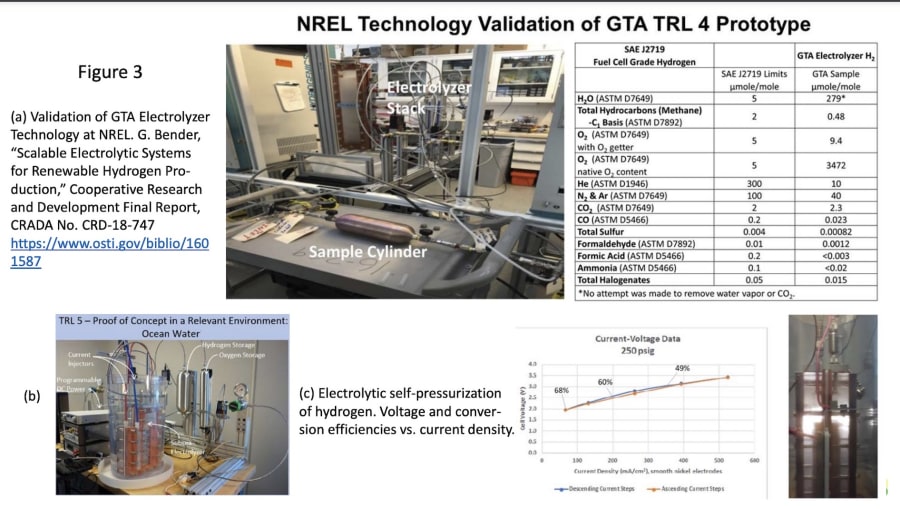GTA introduces the offshore energy field of the future, wherein offshore gas and oil fields transition to gigawatt-scale fields of subsea green hydrogen and oxygen production powered by offshore wind, marine hydrokinetic energy, and ocean thermal energy conversion (OTEC). The enabling technology is GTA’s patented subsea electrolysis of water. GTA subsea electrolytic hydrogen production solves the challenges of safety, resilience, supply chain, opex, and capex. The technology is essential for large-scale decarbonization including manufacturing, transportation fuels, utility grid balancing, marine aquaculture, and combating ocean anoxia.
Pressure-balanced electrolytic hydrogen production, cold water, and hydrostatic pressure at the seafloor are leveraged for electrolyzer cooling and first-stage hydrogen gas compression without a mechanical compressor. Low capex seawater compatible circular commodity materials, including polyethylene, are used for electrolyzer construction. Subsea electrolyzers are failsafe with respect to subfreezing weather during periods of unscheduled power downtime because water at the seafloor never freezes. Proton exchange membrane (PEM) electrolyzers are not failsafe with respect to subfreezing weather. PEM electrolyzers require high purity deionized water that freezes at zero degrees Celsius. When mounted on elevated wind tower platforms above the ocean’s splash zone, as currently proposed, they can be exposed to subfreezing temperatures. During subfreezing periods of power shut down, PEM electrolyzers must have backup power to maintain operation of essential systems and to avoid freezing. Subsea electrolysis systems do not need lift pumps to bring water out of the ocean and transport it to elevated platforms. Positioning the electrolysis system on a platform above the splash zone raises the center of gravity, requiring the ballasting system and substructure dimensions to be modified to ensure floating turbines remain stable. Codes and regulations for floating offshore wind turbines will need to be rewritten to accommodate the additional inertial, aerodynamic, and hydrodynamic forces caused by floating elevated platform mounting.
Behind the meter electricity, wherein wind turbine electricity is sent to the seafloor to power hydrogen production, avoids locating and permitting landfall sites, utility company grid connections, and the capex and opex associated with large power transformers, high-voltage export cables, and floating platforms. Subsea electrolytic hydrogen production provides stable temperature and pressure operating conditions regardless of scale. Diurnal temperature swings, causing internal shear forces that are generated by repetitive expansion and contraction of the abutting dissimilar materials in electrolyzers, are eliminated. Subsea electrolyzers are resilient. They are shielded from lighting strikes and electromagnetic pulse events (EMP). They are also shielded from falling ice from the wind turbine blades, ice floe impacts, hurricanes, and the destructive power of high waves. Subsea electrolyzers, anchored at the seafloor, are 100% compatible add-ons for all existing and future offshore wind farms. The hydrogen is produced and stored safely at the seafloor, in the absence of combustible oxygen, and distant from population centers. Virtually all the operations needed for subsea electrolytic hydrogen production are already being performed by the offshore gas and oil industry, albeit in different contexts. A trained workforce is ready to scale and commercialize subsea green hydrogen and oxygen production now.
Voting
-
ABOUT THE ENTRANT
- Name:Elias Greenbaum
- Type of entry:individual








